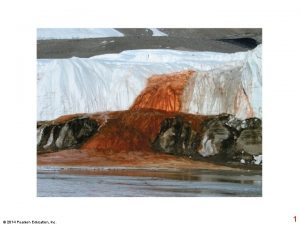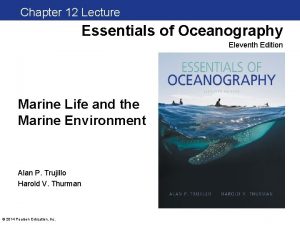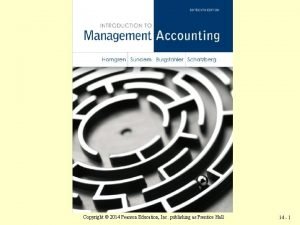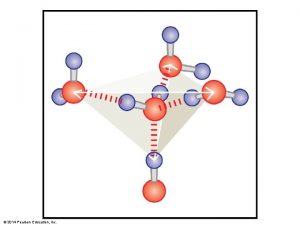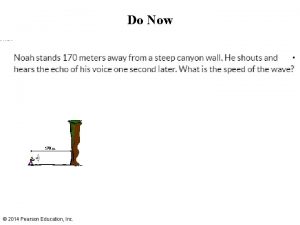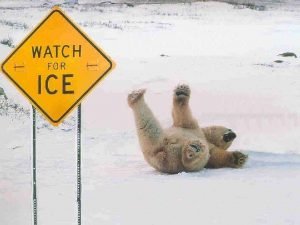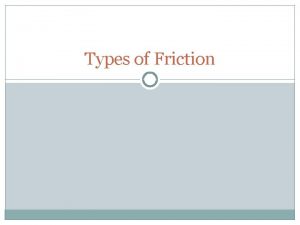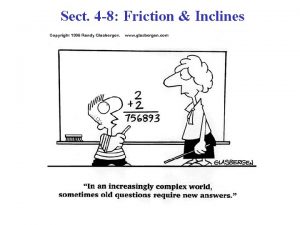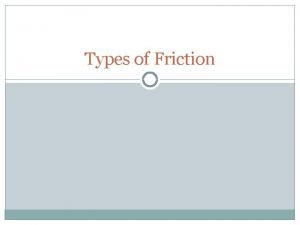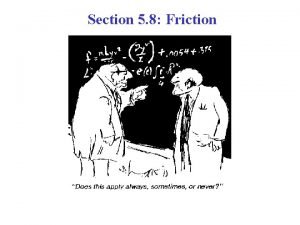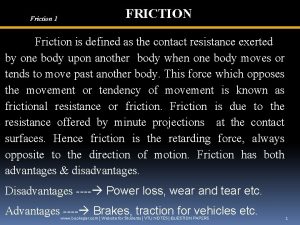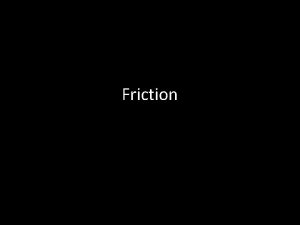3 4 Friction 2014 Pearson Education Inc Friction




























- Slides: 28

3. 4 Friction © 2014 Pearson Education, Inc.

Friction • Friction is the resistance force when 2 rigid solids slide (or attempt to slide) across one another • FYI: Drag is a resistive force when solid fluid flows through a liquid or a gas and has different characteristics © 2014 Pearson Education, Inc.

Static friction © 2014 Pearson Education, Inc.

Static friction © 2014 Pearson Education, Inc.

Static friction • Static friction force is parallel to the surfaces of two objects that are not moving and opposes the tendency of one object to move across the other. • Static friction force changes magnitude to prevent motion, up to a maximum value called the maximum static friction force. • When the external force exceeds this static friction force, the object starts moving. © 2014 Pearson Education, Inc.

Magnitude of the maximum static friction force © 2014 Pearson Education, Inc.

Magnitude of the maximum static friction force: Testing experiment © 2014 Pearson Education, Inc.

Does the maximum static friction force depend on mass? • So: Static friction depends on the normal force (the force the surface exerts on the object) © 2014 Pearson Education, Inc.

Relationship between normal force and friction force • The ratio of the maximum friction force to the normal force is constant in all trials. • The proportionality constant is different for different surfaces; the proportionality depends on the types of contacting surfaces. • The proportionality constant is greater for two rough surfaces contacting each other and smaller for smoother surfaces. • This ratio is the coefficient of static friction. © 2014 Pearson Education, Inc.

Maximum Static Force • Is dependent on – 1. Mass of the object – 2. Normal Force – 2. The type of surface on both the object and the surface the object is sliding on IT IS NOT DEPENDENT ON SURFACE AREA!!! © 2014 Pearson Education, Inc.

Coefficient of static friction • The coefficient of static friction is a measure of the relative difficulty of sliding two surfaces across each other. • The easier it is to slide one surface on the other, the smaller the coefficient is. • This coefficient is unit-less and typically has a value between 0 and 1. © 2014 Pearson Education, Inc.

Static friction force © 2014 Pearson Education, Inc.

Kinetic friction • Kinetic indicates that the surfaces in contact are moving relative to each other. • A similar relationship exists as between the friction force and the normal force, but with two important differences: – The magnitude of the kinetic friction force is always lower than the maximum static friction. – The resistive force exerted by the surface on the moving object has a constant value. SPEED DOES NOT EFFECT KINETIC FRICTION © 2014 Pearson Education, Inc.

Kinetic friction © 2014 Pearson Education, Inc.

• Adjust the force and see where you are on the graph • Note especially where ƒ = Fs Section 4. 5

What causes friction? • Even the slickest surfaces have bumps that can hook onto the bumps on another surface. • Smoother surfaces should have reduced friction, consistent with our previous findings. • If two surfaces are too smooth, friction increases again (for example, two pieces of plastic wrap). – This is due to attraction between particles at the surface that are too close together without typical surface bumpiness. © 2014 Pearson Education, Inc.

Determining friction experimentally: Experiment 1 • The shoe is pulled horizontally with a spring scale until the shoe begins to slide. © 2014 Pearson Education, Inc.

Determining friction experimentally: Experiment 1 (Cont'd) • Just before the shoe starts to slide, its acceleration is zero, and the scale indicates the maximum force of static friction that the tile exerts on the shoe. © 2014 Pearson Education, Inc.

Some Coefficients of Friction Section 4. 5

Tip • The magnitude of the normal force that a surface exerts on an object does not necessarily equal the magnitude of the gravitational force that Earth exerts on the object, especially when the object is on an inclined surface! © 2014 Pearson Education, Inc.

Example 3. 6: Using skid marks for evidence • If a driver slams on the brakes, the tires can lock, causing the car to skid. • Police officers use the length of skid marks to estimate the initial speed of the vehicle. • A car involved in a minor accident left 18. 0 -m skid marks on a horizontal road. After inspecting the car and road surface, the police officer decided the coefficient of kinetic friction was 0. 80. The speed limit was 15. 6 m/s on that street. Was the car speeding? © 2014 Pearson Education, Inc.

Friction Problem • Example 1: a 50. 0 kg desk accelerates at 3. 00 m/s when a 200. N horizontal force is applied. What is the kinetic coefficient of friction? © 2014 Pearson Education, Inc.

Friction Problem © 2014 Pearson Education, Inc.

Friction problem Example 3: A 2. 0 kg object is pulled by a force of 10 N angled at 35 O to the floor. a. Will the object even move if µs =. 55? b. If it does move what is the acceleration? © 2014 Pearson Education, Inc.

Other types of friction • Rolling friction is caused by the surfaces of rolling objects indenting slightly as they turn. – This friction is decreased in tires that have been inflated to a higher pressure. • In Chapter 11, we will learn about another type of friction: the friction that air or water exerts on a solid object moving through the air or water. – This is called a drag force. © 2014 Pearson Education, Inc.

Catalog of Forces Revisited © 2015 Pearson Education, Inc. Text: p. Slide 5 -26

Summary © 2014 Pearson Education, Inc.

Summary © 2014 Pearson Education, Inc.
 2014 pearson education inc
2014 pearson education inc 2014 pearson education inc
2014 pearson education inc 2014 pearson education inc
2014 pearson education inc 2014 pearson education inc
2014 pearson education inc 2014 pearson education inc
2014 pearson education inc 2014 pearson education inc
2014 pearson education inc Water cycle pearson education
Water cycle pearson education 2014 pearson education inc
2014 pearson education inc 2014 pearson education inc
2014 pearson education inc 2014 pearson education inc
2014 pearson education inc 2014 pearson education inc
2014 pearson education inc 2014 pearson education inc
2014 pearson education inc Pearson education
Pearson education 2014 pearson education inc
2014 pearson education inc 2014 pearson education inc
2014 pearson education inc 2014 pearson education inc
2014 pearson education inc 2014 pearson education inc
2014 pearson education inc 2014 pearson education inc
2014 pearson education inc Copyright 2014 pearson education inc
Copyright 2014 pearson education inc Marine species
Marine species 2014 pearson education inc
2014 pearson education inc 2014 pearson education inc
2014 pearson education inc 2014 pearson education inc
2014 pearson education inc 2014 pearson education inc
2014 pearson education inc 2014 pearson education inc
2014 pearson education inc 2014 pearson education inc
2014 pearson education inc 2014 pearson education inc
2014 pearson education inc 2014 pearson education inc
2014 pearson education inc 2014 pearson education inc
2014 pearson education inc






